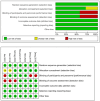Comparison of the efficacy of neoadjuvant chemotherapy and neoadjuvant chemoradiotherapy in locally advanced rectal cancer patients: meta-analysis of randomized controlled trials
- PMID: 39878151
- PMCID: PMC12372722
- DOI: 10.1097/JS9.0000000000002262
Comparison of the efficacy of neoadjuvant chemotherapy and neoadjuvant chemoradiotherapy in locally advanced rectal cancer patients: meta-analysis of randomized controlled trials
Abstract
Background: Preoperative neoadjuvant chemoradiotherapy (nCRT) is considered to be the standard treatment strategy for locally advanced rectal cancer (LARC); however, the risk of adverse events and postoperative recurrence remains significant. This study aimed to evaluate the non-inferiority of neoadjuvant chemotherapy (nCT) compared with nCRT in patients with LARC and to assess the possibility of eliminating radiotherapy on the basis of guaranteed efficacy.
Materials and methods: We searched the PubMed, Embase, and Cochrane Library databases to identify randomized controlled trials (RCTs) comparing the efficacy of nCRT and nCT for LARC. The study protocol was registered with the Prospective Register of Systematic Reviews (PROSPERO).
Results: A total of 2706 patients from seven studies were included in the meta-analysis. There was no significant difference in overall survival (OS) or disease-free survival (DFS) between the nCT and nCRT groups. This study demonstrated a lower rate of infection (OR = 0.53, 95% CI = 0.34-0.82; P = 0.005), anastomotic leak (OR = 0.55, 95% CI = 0.34-0.87; P = 0.01), tumor regression grade (TRG) 0-1 (OR = 0.50, 95% CI = 0.36-0.69; P < 0.0001), preventive diverting ileostomy (OR = 0.41, 95% CI = 0.17-1.02; P = 0.05), and leukopenia (OR = 0.50, 95% CI = 0.25-1.01; P = 0.05) in the nCT group. However, there was no significant difference in the other toxic events, such as intestinal obstruction, urinary complications, diarrhea, and surgical or pathological outcomes, such as clinical fistula, sphincter preservation, postoperative mortality (≤ 60 d), R0 resection, ypStage 0-I, positive circumferential resection margin (CRM+), or pathological complete response (pCR) between the two groups.
Conclusion: This study indicated that OS and DFS were not lower in the nCT group than in the nCRT group. In addition, the nCT group had fewer complications. Preoperative nCT is expected to become a standard treatment option for most patients with stage II-III LARC. It is worth noting that radiotherapy cannot be ignored for some patients who need to ensure the conversion effect of neoadjuvant therapy and strongly request to preserve organ function.
Copyright © 2025 The Author(s). Published by Wolters Kluwer Health, Inc.
Conflict of interest statement
All the authors declare to have no conflicts of interest relevant to this study.
Figures







References
-
- Sung H, Ferlay J, Siegel RL, et al. Global cancer statistics 2020: GLOBOCAN Estimates of incidence and mortality worldwide for 36 cancers in 185 countries. CA: A Cancer J Clinicians 2021;71:209–49. - PubMed
-
- Arnold M, Sierra MS, Laversanne M, et al. Global patterns and trends in colorectal cancer incidence and mortality. Gut. 2017;66:683–91. - PubMed
-
- Wolpin BM, Meyerhardt JA, Mamon HJ, Mayer RJ. Adjuvant treatment of colorectal cancer. CA Cancer J Clin 2007;57:168–85. - PubMed
-
- Cedermark B, Dahlberg M, Glimelius B, et al. Improved survival with preoperative radiotherapy in resectable rectal cancer. N Engl J Med 1997;336:980–87. - PubMed
-
- Kapiteijn E, Marijnen CA, Nagtegaal ID, et al. Preoperative radiotherapy combined with total mesorectal excision for resectable rectal cancer. N Engl J Med 2001;345:638–46. - PubMed
Publication types
MeSH terms
LinkOut - more resources
Full Text Sources

